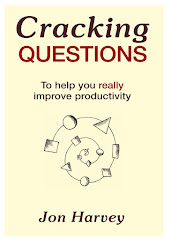

For many years, I have been using this planning model with organisations, partnerships, projects, teams and networks to help them sort through what should be their priorities for the forthcoming period. The model (the idea for which came from an improvement tool called ‘Quality Function Deployment’) has existed mostly in my head supported by a few slides. As a number of people have been asking me for the model – I sat down today to present it in a form that I hope will mean that readers can use the model for themselves. (Whilst this piece is my copyright, the model is yours to use if you wish although I would be grateful of an acknowledgement, of course. I would, indeed, be even more grateful that if you decide you wish to have some facilitation support – you would consider asking me!)
The Principles
Underpinning the model are some key ideas that I think it worth explaining:
- You cannot have 347 targets / priorities / must do’s – that is not possible. A few aims are all that you need. These may be nested together so that what is one person’s broad aim can turn into a series of ‘sub-aims’ for the team that person looks after or represents. The trick is knowing what few aims to tackle. As Michael Porter said “the essence of strategy is choosing what not to do”.
- Knowing ‘what’ you have to achieve provides focus – but it does not provide you with the method to get you there. To achieve something requires clarity about the ‘how’s’
- Everything should start with whom you are serving – their needs, their wishes, their hopes... their demands are what is critical. Assessing what you do and what you are achieving should start from this angle.
- Everything is a system – which has various subsystems and which is part of a bigger system. In other words everything connects. The trick in improving what you are achieving is understanding the system more and more so that you can intervene in it effectively.
- Variation is what matters – knowing what causes of variation are under your control and what causes of variation are not is the lodestone of continuous improvement. Improving how you are working does not come from exhorting people to just try harder. Improvement comes from understanding systemic variation, performance comes from application of that understanding.
The matrix planning model begins with knowing your aim – just what impact do you hope to have on the world – what are you (and your team / partnership / network / project) here to achieve? This aim maybe long term or it may be relatively short term (an aim can be just for a year). Planning activity and improvement comes from knowing where you wish to go.
Critical Success Factors
In this model – CSFs are defined as the ‘few key things you must achieve in order to be sure that you are making substantive progress towards achieving your overall aim’. Please note ‘few’ and ‘must’. By few I mean no more than 8, perhaps 9 at a squeeze – but emphatically no more. In short, CSFs are the few key things you must get right. Usually I get groups to generate their list of CSFs after a brainstorm on all the things that might get in the way of them achieving their overall aim. Then it is a question of reviewing the brainstorm – in the light of other strategic assessments and user/citizen/customer feedback – to synthesis eight distinct ‘what’s’ which need to be realised. These CSF’s may be a mix of short, medium and long term objectives. Whilst the achievement of these CSFs cannot be directly managed, they can and should be measured (a point I will return to below). The final test is to be sure that each one of the CSFs is necessary and together they are sufficient to achieve the overall aim.
Work Processes
Work processes are the ‘how’ of making the CSFs happen. In any organisation, partnership or team there are streams of activities which can be reasonably easily lumped together to be called distinct processes. A process can be defined as a logically connected set of activities which deliver an output, outcome or service of some kind. Most organisations would have a ‘recruitment process’ for example. Most partnerships will have a ‘public engagement process’ and so forth. These processes have to be constructed from a brainstorm and clustering of ‘what are all the things we do?’ Each process should be discrete and not overlap with another process. Processes are usually labelled in the form of a doing sentence such as ‘recruiting people’, ‘writing blogs’ etc. Usually a partnership or organisation (or department / team / project) will end up with about 18 to 24 processes – but there are no definitive rules here. Like CSFs, processes are measurable. Indeed it is critical to measure processes to check on their performance. Processes have a beginning, middle and end – and create something. Processes are what people do. Having established the list of processes, it should then be possible to place anything that somebody does (in the organisation / partnership / team / project etc.) into one of the processes.
Connecting the CSFs with the Processes
This is stage when the model really begins to take shape. You now need to create a two dimensional matrix with the CSFs at the top and the processes down the side. Taking each CSF at a time (and it is important to work by CSF not by process) decide which of the processes need to be done especially well in order for the CSF to be achieved. Note the ‘especially’ – as if it was just ‘well’, then probably all the boxes would be ticked. It should then be possible to test the ‘necessary and sufficient’ rule to the processes for a CSF. Of the processes ticked – are they all necessary to achieve the CSF and together sufficient to do so? If yes move on to the next CSF column. (If no, then you may have to create a new process or two – which sometimes happens.) The end point of this stage will be a matrix where some boxes are ticked and not others (see example below).
Prioritising
The next stage is to decide which process to focus your energies on improving. One indicator (not ‘measure’ as this would give it a spurious accuracy) is how many ticks a process row has. The more ticks means you have judged that process to be critically impacting on a bigger number of CSFs. On that basis, it is probably more important to ensure a process with 7 ticks is functioning well than one with just a couple. But that is not the only factor. You also need to take a view on how well the process is currently functioning. Again using data from external users/citizens/customers as well as the combined judgement of the team doing the planning, you will need to come to a view as to how effective/efficient/flexible/sustainable each process is. Usually I put this on a five point scale where A means ‘brilliant process, works like a dream, always delivers its outputs right first time’ to E which means ‘very poor process, indeed what process, do we even have this process??’. You then have a means to select the processes which require the most attention and nurturing. The task is to decide which processes are so important (number of ticks) and work so badly (scoring 4 or 5 on the scale) that urgent effort is required to improve them. This prioritisation is at the heart of this model.
Improving processes
It would take another piece to describe what can be done to improve and redesign processes but one key start is to appoint a ‘process caretaker’. This is the person whose job it will be to develop the process so that it works more elegantly. Often this person has more of an investment in making the process work well. But they are not the process manager – since processes are by their nature cross cutting (across departments, units, agencies etc.) it makes better sense in my view to call them a caretaker. (Indeed can any process be ‘managed’?) Moving beyond assigning the role of caretaker, the process then becomes one of asking some fundamental questions about the process such as what requirements / demands is it there to fulfil, do we have to do the process this way, could we drop some of the stages and so forth. (I would caution you against endless n’th level process mapping since I find that saps the creative spirit and makes the ‘as is’ process far too easy to hold onto – but that is probably another debate.)
On one page (nearly!)
Having done this – it then becomes possible to place all of your plans about improving your partnership / unit / organisation / project onto one page. The matrix could well end up looking something like the embedded pictures
In this example – the links between the 8 CSFs (on slide one) are linked to the processes on slide two.
Measurement and ‘Balanced Scorecard’
As mentioned above, it is helpful to have some measures on the CSFs as well as the processes. Although the CSFs are not (by definition) manageable – assessing how well they are being achieved can be very helpful as a mechanism to check overall progress. Usually I advise teams to find one, two or three (maximum) performance indicators (not targets) that can be attached to each of the CSFs. In this way, they end up with a ‘dashboard’ (or balanced scorecard) of indicators to keep an eye on. What is then useful also is that if a CSF begins to show a negative trend in its indicators, it is then possible to use the matrix to diagnose where the problems might be. In other words if, in example above, the indicators around CSF 2 began to show some worrying trends, then the chances are that looking at what is happening with the processes ticked for that CSF (processes 1, 2 and 6) might yield a solution to the problem.
Conclusion
I hope this piece gives you enough of an outline as to how to use this model. In a piece of this length, I have taken some short cuts on the explanation, so if you wish, please email me and I will do my best to respond with any help that I can. (jon@jonharveyassociates.co.uk)
© Jon Harvey 2009








.jpg)



No comments:
Post a Comment